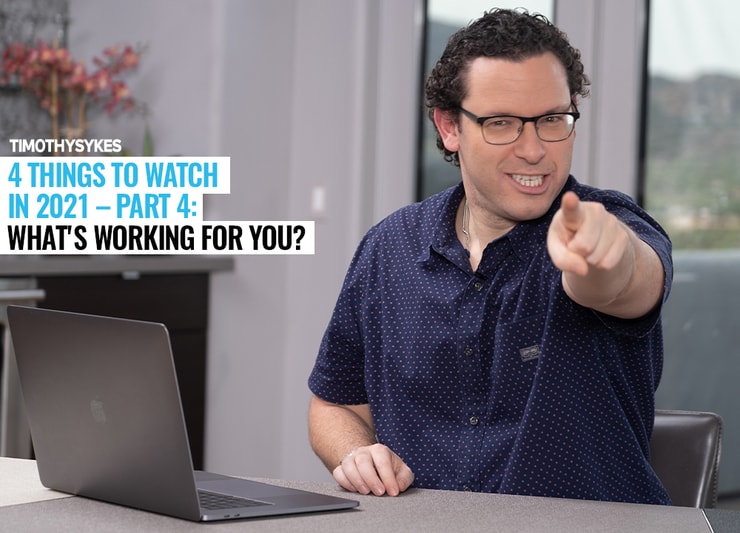One of the weird things about being transparent is that I talk to a lot of traders. Maybe more than any other trader in the world. I don’t say that to brag. I say it to help you understand why just knowing what’s working isn’t enough.
When I talk to traders, I see where they’re having problems and where they’re doing well. And I see that what’s working for one trader doesn’t always work for another. Yes, you should try to figure out what’s working now. (Keep reading for more on that.)
But ultimately you must…
Table of Contents
Look for What’s Working for YOU
What’s working for you? If I asked my top students that question, I’d get a variety of answers. Every single person reading this will have a different answer.
Some people like buying morning panics, some like short selling pumps. Others like first green day OTCs. Look to patterns that work for you.
Again, going back to part 2 of this series, don’t try to predict. If you say “We’re gonna see short squeezes, hot biotechs, and hot OTCs in 2021, so that’s what I’m gonna play…”
(Catch up on the rest of this series. In part 1, I cover the trading mindset. Part 2 digs into 2021 predictions. And in part 3, you can learn a smart approach to your everyday trading.)
Guess what? Who KNOWS what’s gonna happen in the future? Who knows which sectors will overperform or underperform? Predictions set you up for disappointment.
You have to find what’s working. And you have to figure out, specifically, what’s working for YOU.
Focus on What’s Working
I get this question a lot … “How do I figure out what works best for me? Can’t you just tell me what to do?”
NO! Stop! I can’t tell you what you’re good at. All I can do is show you the patterns and strategies I’ve learned over the years.
So the way to figure out what works for you is to first figure out…
What’s Working Now?
Keep in mind that I adapt to the market. What’s working today might not work tomorrow. And what works for me might not work for you. This is so important if you want to stay in the game long term. You must adapt to the market over time.
So part of figuring out what’s working now is to study other traders. The more consistent they are, the better. What am I trading? Which patterns are working for me? How about Roland Wolf, Jack Kellogg, or Kyle Williams … are their favorite patterns working for them right now?
OK, what about Tim Grittani, Tim Lento, or Michael Goode? What’s working for them now? And, more importantly, how is it working?
Then, as you come to grips with what’s working now, try to figure out what works for you.
Focus on What’s Working and Track It
You have to be focused on what’s working and keep track of it.
A lot of my top students use spreadsheets to track different strategies and patterns. I don’t because I remember these patterns. I’m not a spreadsheet person. You can choose whatever you want.
If it will help you to use spreadsheets, then do it. I especially encourage you to do it if you can’t narrow down your pattern or strategy. Some people think one setup is their best — only to later find that the data tells a different story. They realize they’re more consistent with another pattern.
More Breaking News
- Inauguration Week: Trading Volatility in Trump’s Second Term
- From Dreams to Reality: Can Lucid Group Power Through Market Setbacks?
- Quantum Leap: Is IonQ’s Stock Set to Skyrocket?
Track Setups
So track it. You don’t even have to trade a pattern to gather data. Tim Grittani is a perfect example. He sets up criteria and then tracks a setup over time to see if it’s worth pursuing.
The key to the most success over time is not who wins the most the fastest, but who learns the most the fastest & then applies those lessons to win far bigger over time. I fear too many people who banked in 2020 learned the wrong lessons that will hold them back for years to come
— Timothy Sykes (@timothysykes) January 12, 2021
Too many people want instant gratification. Want to know how Tim Grittani has been so successful?* By being meticulous.
(*These results are not typical. Individual results will vary. Most traders lose money. My top students and I have the benefit of many years of hard work and dedication. Trading is inherently risky. Always do your due diligence and never risk more than you can afford to lose.)
Track Your Trades
See what your winning percentage is … Track your average win and loss. Keep track of your biggest win and loss. But do it with every trade and every pattern.
That might mean taking a lot of very small trades for a while. You won’t know what you’re good at and what works best for you until you’ve tested.
Test everything. Track everything. Then pay attention to what the data tells you.
Sometimes I wish I was patient enough to do that. Meanwhile, I’ll just keep trading…
Patterns That Keep Working
I can’t promise my patterns will keep working. Again, I don’t predict the markets. But I can say the patterns I trade have been happening for 20 years.
Just remember that pattern is only one of the seven indicators I look at. You must learn to consider all seven. With that in mind, I’ll keep watching for…
Morning Panic Dip Buys
Every day I look for morning panic dip buys. Look at all my watchlists and you’ll see stocks where I’m looking for the panic. (Sign up for my weekly watchlist here.)
Morning panics have worked since last year. They’re not all exactly the same. And to trade them well takes practice. But it’s one of the simplest patterns out there. When penny stocks get overextended, they tend to come down. When they get WAY overextended, they come down hard. And when everything is right, they bounce like a ball.
But that doesn’t mean you can just buy any panic. Don’t try to catch a falling knife. Instead, learn how to dip buy morning panics effectively. Then start small and practice.
Breakouts
I still love buying breakouts. They don’t always work, but there have been some solid breakouts recently.
Beware of chasing. Sometimes the breakouts I buy are multi-day or multi-month. Other times I buy an intraday breakout. (See above regarding seven indicators. When I buy a breakout, the pattern is NOT all I’m thinking about.)
First Green Days OTCs
First green day OTCs are a perfect example of adapting to the market. They’ve come in waves this year. Sometimes they’re good overnight holds. Other times it’s much better to sell into the close.
In early December 2020, it was working well to hold overnight. But a month prior, they were better to sell into the close. They didn’t gap up the next day. Then, toward the end of December, sometimes they didn’t gap up again.
Again, look at what’s working right now in any single day, week, or month.
StocksToTrade Breaking News Plays
I’m always looking for STT Breaking News Chat plays because they’ve worked for me. Understand that part of the reason they work so well for me is experience.
(Quick disclaimer: I helped design and develop StocksToTrade. I’m also a major investor.)
I know a lot of these stocks from trading them in the past. I’ve traded different sectors and different kinds of markets. It all comes into play. What I love about the Breaking News Chat alerts is they help me filter out the noise. I know something is at least worth looking at if they alerted it.
Note that this doesn’t mean I trade everything they alert. I don’t. But the number of winning trades I’ve taken after their alerts is undeniable.* I’m talking probably half of my winning trades in 2020.* So for me, it’s been a game-changer.
(*Please note: My results are far from typical. Individual results will vary. Most traders lose money. I have the benefit of years of hard work, dedication, and experience. Trading is inherently risky. Do your due diligence and never risk more than you can afford to lose.)
Patterns to Avoid
Along with patterns to learn, there are patterns to avoid.
Some patterns take longer than others to learn or find consistency with. That’s why I teach my students to find what works for them by testing small. Then, once you have a pattern that works, you can start working on other patterns.
But there’s one pattern I think every new trader or anyone with a small account should avoid right now…
Aggressive Short Selling
Aggressive short selling has been dangerous for a lot of people this year. And it doesn’t matter how crappy or sketchy the companies are. Huddie, is one of my top students. To date, he reports profiting approximately a quarter of a million dollars primarily from Short selling has been difficult. Even for short sellers who claim they’re making a lot…
First, they’re not showing all their losses. Second, they’re not showing the risks they take or the stress they experience.
You CANNOT just buy & hold any hot #Bitcoin or #cryptocurrency play & keep HODLing or short any penny stock because it has weak fundamentals, those strategies might work well in the short-term, but you'll get crushed in the long run just like all gunslingers learn the hard way!
— Timothy Sykes (@timothysykes) January 12, 2021
Random Patterns
Don’t trade random patterns. Random patterns will only frustrate you and lead to pain. Avoid random patterns.
Hopefully, that’s clear. But let me remind you one more time … Don’t trade random patterns.
How to Make 2021 Your Breakout Year
I can’t promise 2021 will be your breakthrough year. A lot is determined by your work ethic and self-discipline. As always, I have to ask…
How bad do you want it?
NEVER FORGET 90%+ OF TRADERS LOSE, & IT'S DUE TO LACK OF DISCIPLINE & BEING UNABLE TO CONTROL THEIR EMOTIONS IN THEIR TRADING! HOW BAD DO YOU WANT TO SUCCEED? THE ANSWER DEPENDS ON HOW HARD YOU STUDY & THEN HOW WELL YOU FOLLOW YOUR PLANS AND NOT DEVIATE WHEN ANGRY/SAD/FRUSTRATED!
— Timothy Sykes (@timothysykes) January 7, 2021
How much time and effort are you willing to put in to find what’s working for you? Trading isn’t rocket science. But to be successful you need a combination of knowledge, discipline, and experience.
My top tip for how to make 2021 YOUR breakout year is…
Whatever your level, wherever you are in life, take advantage of one or more of these…
Trading Education Resources
I get questions from people all the time asking how they can learn to trade. What you should know is…
My team and I put together a wide variety of resources. From free, to no-cost, low-cost, or a monthly subscription. And for the most dedicated, there’s the Trading Challenge.
In other words, you get to choose. But do yourself a favor … Whatever your situation, don’t make excuses.
FREE Trading Education Resources
This is a great place to start if you’re brand new to penny stocks and need more information. Penny stocks have a bad reputation. Take advantage of these resources to see why I LOVE them.
FREE Penny Stock Guide
If you’re new and want to learn more about penny stocks start here.
YouTube
At the time of writing, I have over 1,400 videos on my YouTube channel. And they’re all free. Like this one…
Prepare for 2021 Now With 21 Tips for Penny Stock Trading
Everyone interested in trading penny stocks should watch these videos. Take notes and learn. There’s so much information there if you’re willing to focus.
An American Hedge Fund
Download a copy of my best-selling book for no cost here.
Low-Cost Trading Education Resources
Ready to invest in your education but not ready to go all in? That’s OK. Check it out…
The Complete Penny Stock Course
It blows my mind that more people don’t read this before they start trading. “The Complete Penny Stock Course” is basic, but that’s the point. My student Jamil wrote it and included ALL the basics so you won’t miss anything. Get it. Read it. Take notes.
30-Day Bootcamp
This is the next step up. You get all the basics in 30 video lessons, including worksheets and quizzes. Plus, you get “The Complete Penny Stock Course” book AND my “Pennystocking Framework” DVD as bonuses. Start the 30-Day Bootcamp today.
Monthly Plans on Profit.ly
We have monthly plans for different budgets. Check out Pennystocking Silver and TimAlerts here.
Trading Challenge
All my top students come from the Trading Challenge. If you’re ready to immerse yourself, apply for the Trading Challenge here.
Tools for Traders, By Traders
StocksToTrade is the scanner I use every day. StocksToTrade Breaking News was a game-changer for me in 2020.*
Ready to find what’s working for YOU in 2021? Comment below, I love to hear from all my readers!





Leave a reply